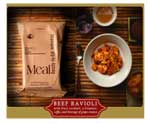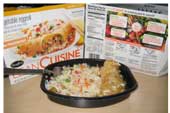Why this is Important
"I don't know how to cook. At all. We eat takeout or frozen meals. How can I begin to store 6 to 12 weeks of shelf-stable food in my pantry? We don't LIKE canned foods or powdered milk! We don't eat that kind of food. And, we're not made of money. We can't afford to buy food we won't ever eat."
Does this describe you? Here are four options.
Option 1: Buy a 12 week supply of MREs

MREs or "Meals Ready to Eat" have been used by the military for years. Telling kids that "this is what the soldiers eat" helps many kids eat them. If stored properly (cool and dry), they have a long shelf life. Be sure to check expiration date before purchasing.
- Advantages – easy, no need to plan or cook, wide selection, taste is acceptable to good
- Disadvantage – expensive
Option 2: Buy all ready-to-eat foods

Many people purchase ready-to-eat foods in the event of a hurricane or natural disaster. This is also a good idea during a pandemic, because the foods are easy to heat and serve, especially if one is ill. Some can be frozen, but to have a three months supply, you will also need canned and packaged food. Look for foods that you like that have a longer shelf life, in the unrefrigerated section of the grocery store. Crackers, shelf stable cheeses, puddings, cereals, toaster pastries, tuna packets, shelf stable meals, soups, chili, and pancake mix can be a good route to starting a pantry.
Many soups are designed for people trying to lose weight, so they have very few calories. Get extra oil such as olive oil and some pasta or rice to add to the soups to make them more nutritious and filling. As long as you can boil water, you can make instant cup-o-soups and oatmeal packets.
- Advantages – many of these foods may already be part of your normal diet, and can be used on a regular basis. It is easy to determine how much food you have.
- Disadvantages – if utilities fail, you may lose your frozen foods. This option is more expensive than cooking from staples, as you are paying for single servings, packaging and processing. Shelf life is not as long as for MREs or pantry staples packaged for long-term storage.
Option 3: Learn basic cooking of pantry staples
Learning to use pantry staples is an excellent way to stretch your preparation budget! Pantry staples are generally much cheaper than mixes or ready-to-eat foods. Also, learning to cook pantry staples gives you more options. If you buy a muffin mix, you can only make muffins. However, if you buy the staples that went into the muffin mix (sugar, salt, fat, flour, leavening) you can make: muffins, pancakes, waffles, noodles, biscuits, cakes, dumplings, breads, cookies, and more! Recipes for these are as easy to follow as the instructions on the back of the muffin mix.
Try learning to cook at least simple foods now, trying a new recipe once or twice a week. The ingredients are inexpensive, and you do not lose anything by trying. Get your kids used to eating them. Teach younger children and teens how to cook them safely so they can help in an emergency.

- Advantages – Foods prepared from pantry staples are simple, cheap and healthy. Basic meals are easy to learn and prepare, even for those who have never cooked. They are also very inexpensive, enabling you to afford to stock 12 weeks of food. For example, $20 spent at a fast food chain can buy you the supplies for at least 10 meals using staples. If you incorporate these staples into the meals that you eat each week, you will be accomplishing two things: enjoying home cooked meals and saving money. This will also allow your family to become accustomed to different flavors, and will build your confidence as a home chef. Even famous chefs burn their food occasionally. Try new recipes in an afternoon or on weekends when the family can sample and you can experiment without anxiety.
- Disadvantages – requires some cooking time, may require some practice, and requires a heat source to prepare.=
The
"Bare Basics Cook Plan" (see
downloads section on this website's homepage) is for people who have never met a cookbook or boiled a pot of water -- the most basic plan imaginable -- for turning very basic pantry items into meals.
It will tell you what to buy, and how to prepare it. Except for bread, all recipes can be prepared over a burner (camp stove) with a single pot or frying pan.
BARE BASICS COOKING IDEAS - Hot cereal (oatmeal, rice): with fruit, cinnamon, syrup, or nuts
- Pasta (spaghetti, macaroni): with jarred sauce
- Tortillas: with various toppings
- Stew: with various flavorings
- Pilaf (whole grain plus vegetables or canned meats)
- Basic bread (no eggs): bread may be prepared in an oven, a solar oven, or a dutch oven
- Pancakes
- Chili
Your recipe for success - Download "Bare Basics Cook Plan" from the downloads section on this website
- Purchase some suggested basic ingredients and start cooking, using the techniques described in the "Bare Basics Cook Plan"
- Reinvest your savings into additional preparation supplies
Note: If you have special dietary needs, conditions or allergies, you will need to alter this plan to fit your needs. Be sure to consult your healthcare practitioner.
Option 4: Supplement Stored Food with Fresh Food
Supplement stored foods with fresh food you grow yourself. If you are a beginning gardener or have limited space, investigate "Lasagna Gardening" and "Square-foot Gardening." Consider planting disease-resistant fruit varieties that grow in your area. Even a few big pots on a deck or balcony can help you satisfy a craving for salad or a few berries in your oatmeal or the bright flavor of fresh herbs in your recipes. Buy plants, seeds and supplies now. Start small and learn season by season. If you buy non-hybrid seed, you can collect seeds from this year's crop to plant next year.